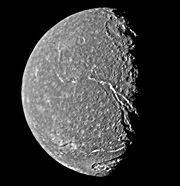
Gertrude (crater)
Encyclopedia

Impact crater
In the broadest sense, the term impact crater can be applied to any depression, natural or manmade, resulting from the high velocity impact of a projectile with a larger body...
on Uranus
Uranus
Uranus is the seventh planet from the Sun. It has the third-largest planetary radius and fourth-largest planetary mass in the Solar System. It is named after the ancient Greek deity of the sky Uranus , the father of Cronus and grandfather of Zeus...
's moon
Natural satellite
A natural satellite or moon is a celestial body that orbits a planet or smaller body, which is called its primary. The two terms are used synonymously for non-artificial satellites of planets, of dwarf planets, and of minor planets....
Titania
Titania (moon)
Titania is the largest of the moons of Uranus and the eighth largest moon in the Solar System at a diameter of 1578 km. Discovered by William Herschel in 1787, Titania is named after the queen of the fairies in Shakespeare's A Midsummer Night's Dream...
. It is about 326 km across, 1/5 of Titania's diameter. It is named after the mother of Hamlet
Gertrude (Hamlet)
In William Shakespeare's play Hamlet, Gertrude is Hamlet's mother and Queen of Denmark. Her relationship with Hamlet is somewhat turbulent, since he resents her for marrying her husband's brother Claudius after he murdered the King...
in William Shakespeare
William Shakespeare
William Shakespeare was an English poet and playwright, widely regarded as the greatest writer in the English language and the world's pre-eminent dramatist. He is often called England's national poet and the "Bard of Avon"...
's play Hamlet
Hamlet
The Tragical History of Hamlet, Prince of Denmark, or more simply Hamlet, is a tragedy by William Shakespeare, believed to have been written between 1599 and 1601...
. Features on Titania are named after female Shakespearean characters.
The crater rim of Gertrude is elevated by 2 km over the crater floor. In the center of the crater there is a large dome, which resulted from the uplift of the surface immediately after the impact. The dome has the diameter of about 150 km and is 2–3 km high. The rim and dome are low for crater with such a large diameter indicating that the relief has relaxed since the impact. The surface of the dome has only few superimposed smaller craters, which means that it was modified later.
External links
- Gertrude peeks over the terminator at the Planetary Society

